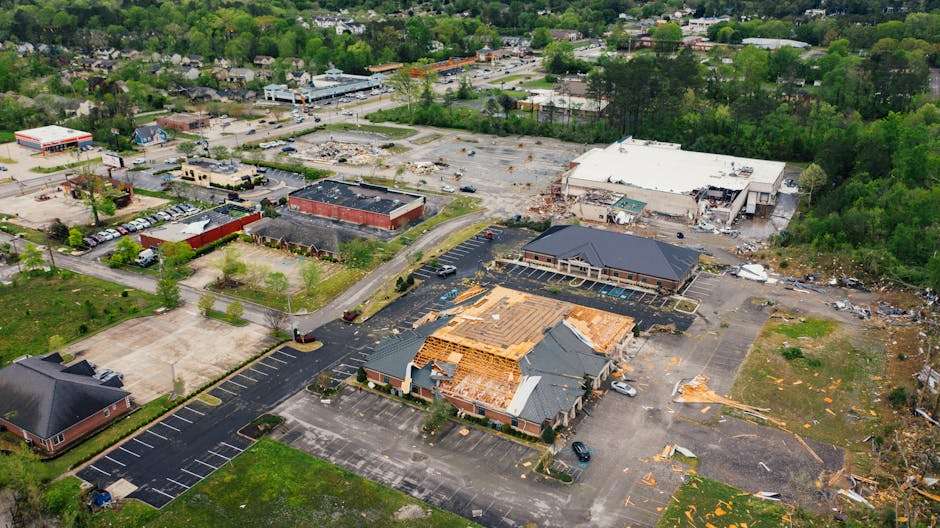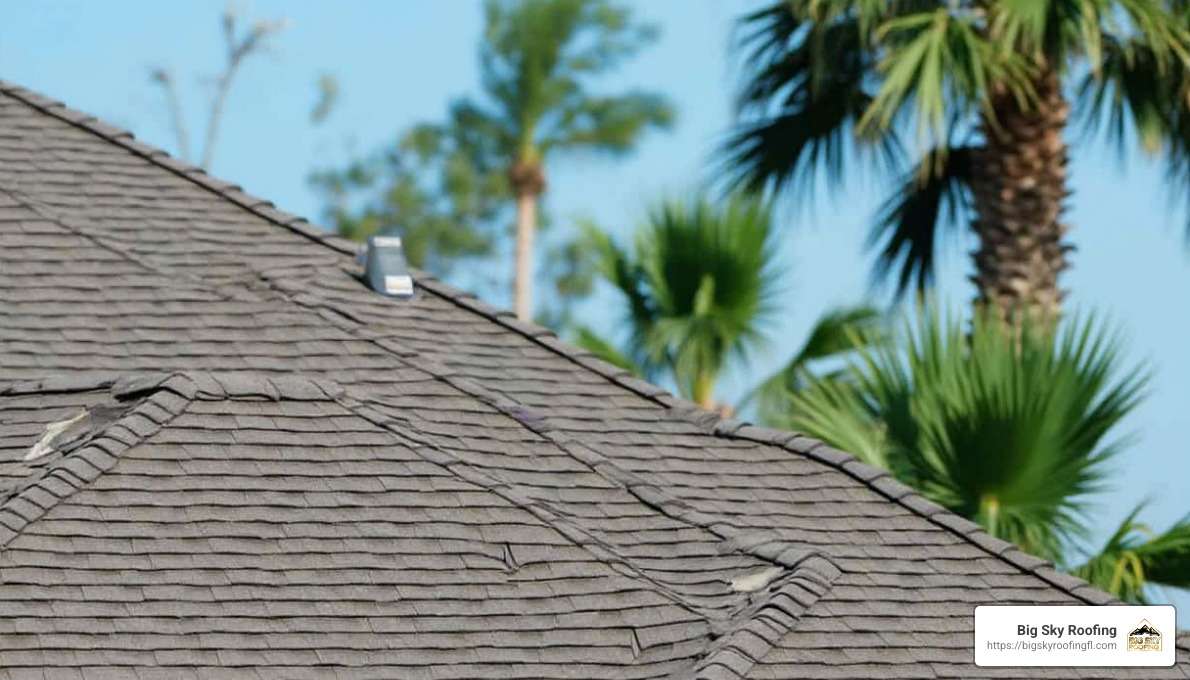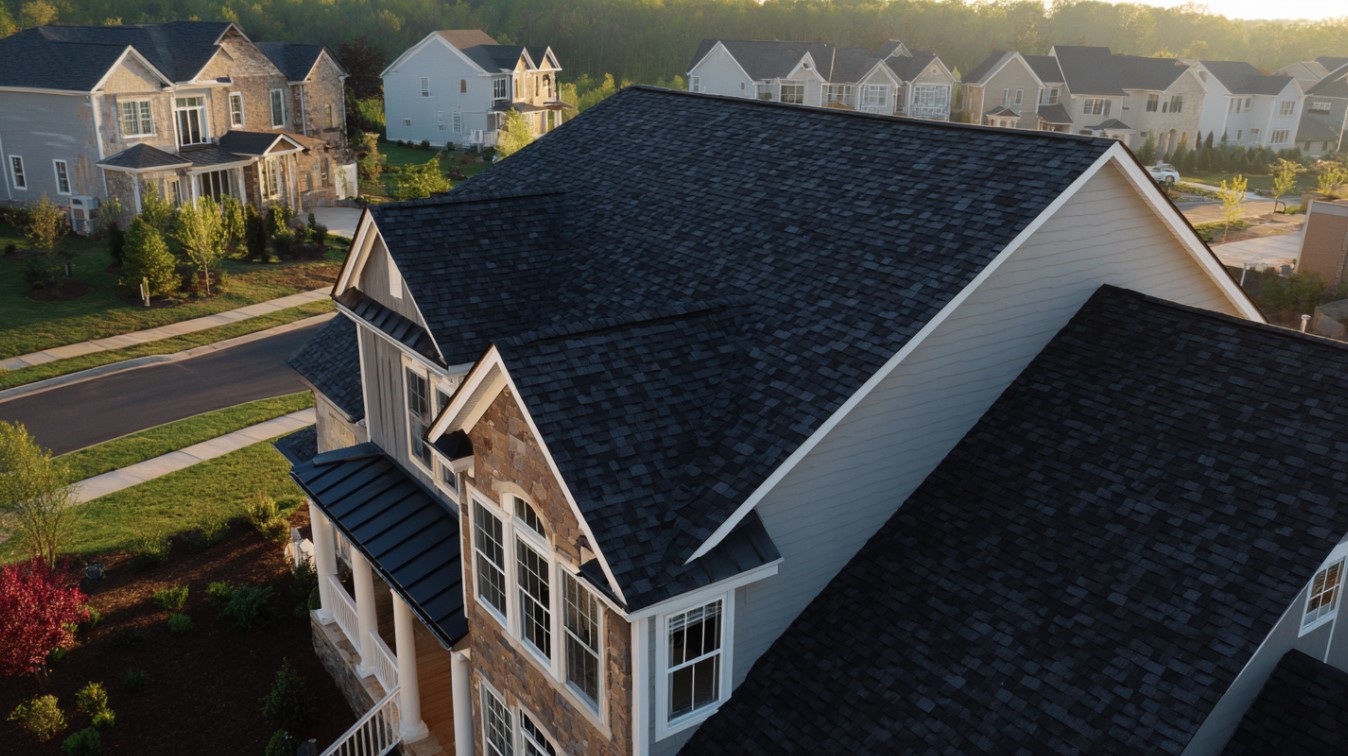Your Guide to Estimating Roof Costs for 1000 Sq Ft Homes
•
Written By

What to Budget for Your 1000 Square Foot Roof
Planning for a new roof shouldn’t give you a headache—or empty your wallet unexpectedly. If you’re searching for a roof estimate 1000 sq ft in Central Florida, let’s break down what you can expect to pay:
Your roof is more than just the cap on your home—it’s your family’s shield against Florida’s infamous heat, humidity, and those surprise afternoon thunderstorms. For homeowners in Sumter, Lake, Citrus, Hernando, Orange, and Marion counties, understanding what goes into your roofing budget helps you prepare properly.
Most Central Florida homeowners spend around $7,000 for quality architectural shingles on a 1,000 square foot cross-gable roof. That said, your final bill could swing lower or higher depending on your material choices, how complex your roof is, and current labor rates in your specific county.
Roofing professionals don’t think in square feet—they work in “squares.” Each square covers 100 square feet, so your 1,000 square foot roof translates to 10 roofing squares. For a typical asphalt shingle job, you’ll need about 30 bundles of shingles (that’s 3 bundles per square), plus all the supporting materials like underlayment, flashing around chimneys or vents, and proper ventilation components.
When planning your budget, labor typically eats up about 60% of your total cost, while materials account for the remaining 40%. Under sunny Florida skies with cooperative weather, professional roofers can typically complete a standard 1,000 square foot installation in just 1-2 days.
As one of our experienced foremen likes to say, “Sooner or later, every roof requires replacing.” Understanding these cost factors now will help you make smart decisions when that inevitable day arrives for your home.
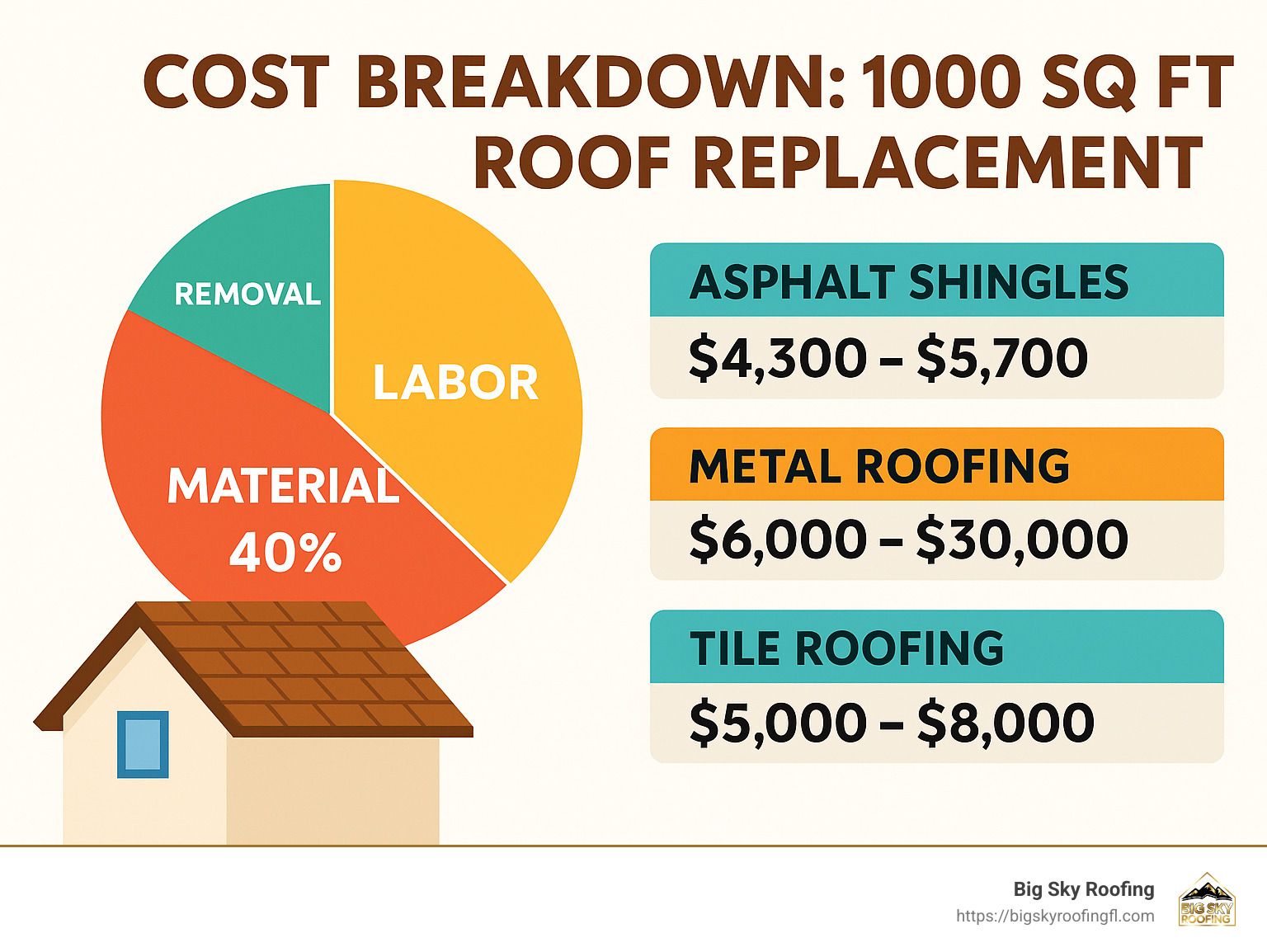

Want to learn more about roof estimate 1000 sq ft costs? These resources can help:
– average cost of a new roof
– how much does a metal roof cost
– roofing cost estimator
Understanding the Basics of a Roof Estimate 1000 Sq Ft
When you’re seeking a roof estimate 1000 sq ft, it helps to understand how we roofing pros calculate your costs. The roofing world has its own special language that might seem a bit like Greek at first!
Let’s start with the basics. In roofing, we don’t just measure in square feet – we use “squares.” One roofing square equals 100 square feet of roof area. So when you have a 1,000 square foot roof, we’re looking at 10 roofing squares. This measurement helps us quickly estimate how much material your project will need.
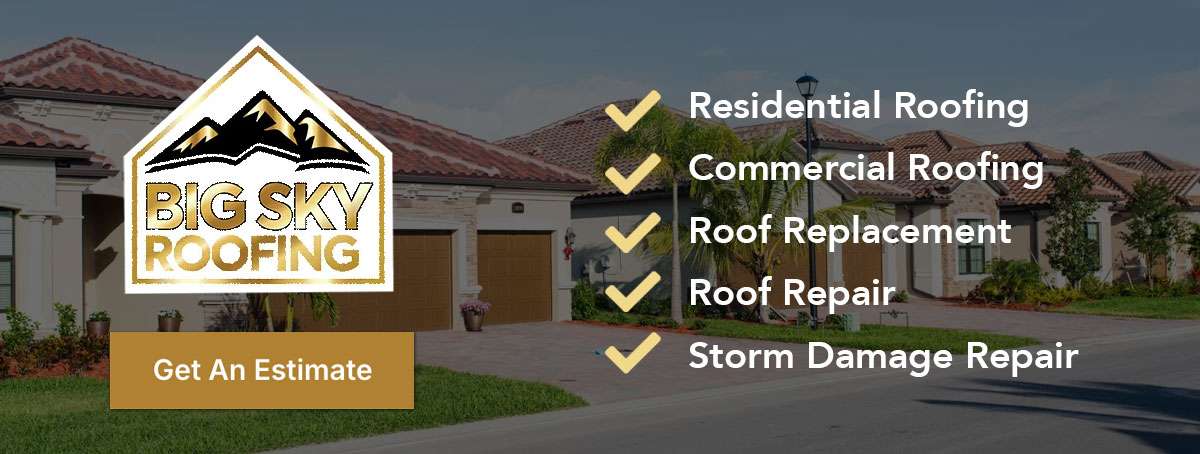
Here in Central Florida, asphalt shingles remain the most popular roofing choice, and they’re typically sold in bundles. For standard 3-tab shingles, you’ll need about 3 bundles to cover one square. That means your 1,000 square foot roof (or 10 squares) will require approximately 30 bundles of shingles.
“To provide you with the most accurate and up-to-date cost figures, we gather information from a variety of pricing databases, licensed contractors, and industry experts,” explains Adam Graham, a roofing industry expert. This comprehensive approach ensures our estimates reflect real-world costs.
In our experience serving Sumter, Lake, Citrus, Hernando, Orange, and Marion counties, labor typically makes up about 60% of your total roofing expense. This percentage runs higher than some other regions because Florida homes need special attention to hurricane wind resistance requirements. The remaining 40% generally covers materials, though these percentages can shift depending on your material choices and roof complexity.
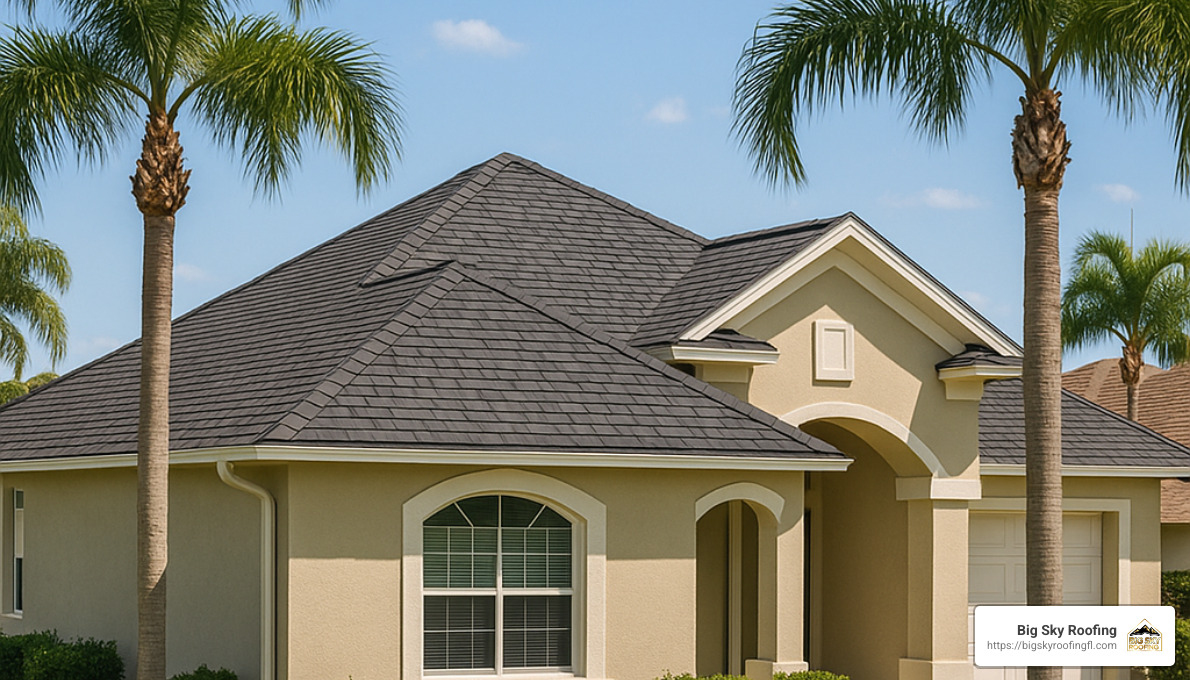

Why Size, Pitch & Shape Matter
When calculating a roof estimate 1000 sq ft, the footprint is just the starting point. Your roof’s pitch (steepness) and shape dramatically impact the final cost – sometimes by thousands of dollars!
Your roof might be a gable roof with its simple triangular shape, a hip roof where all sides slope downward, a modern flat roof, a more complex cross-gable roof with sections meeting at right angles, or perhaps a distinctive mansard roof with its double slope on all sides.
Each shape requires different amounts of material and labor. A straightforward gable roof usually costs less to replace than a complex design with multiple valleys and ridges. Those intricate areas require more careful waterproofing and take more time to complete properly.
Roof pitch matters too! We express pitch as a ratio – like 4:12 or 6:12 – showing how many inches your roof rises for every 12 inches of horizontal distance. When your pitch gets steeper (above 6:12), expect to add $1,000 to $3,000 to your total cost. Why? We need additional safety equipment and the installation becomes more challenging.
To calculate your actual roof surface area, we use a pitch factor. For example, if you have a 1,000 square foot home with a 6:12 pitch roof, you might actually have around 1,250 square feet of roof surface to cover. That’s 25% more material and labor than the simple footprint suggests!
Timeline for a 1,000 Sq Ft Tear-Off & Install
For a standard 1,000 square foot roof, we can typically complete the replacement in 1–2 days under sunny Florida skies. This timeline assumes we’re removing one layer of existing shingles and installing new asphalt shingles on a roof with moderate pitch.
Several factors might extend our visit to your home:
Our crew size matters – a team of 4-5 experienced roofers can knock out a 1,000 sq ft roof efficiently. At Big Sky Roofing, we make sure to send appropriately sized crews to keep your project on schedule.
Those afternoon weather windows in Central Florida can be tricky! Summer thunderstorms often roll in after lunch, so we carefully plan around weather forecasts to maximize productive time.
Roof complexity plays a big role too. If your home features multiple valleys, dormers, skylights, or chimneys, we’ll need additional time to ensure everything’s properly flashed and watertight.
Your material choice affects timing as well. While we can install asphalt shingles quickly, premium materials like tile or slate require more time due to their weight and specific installation requirements.
The existing roof condition might surprise us – if we find your roof deck needs repairs once we tear off the old shingles, this will naturally add time to your project.
Our professional team follows a structured process that typically looks like:
– Day 1 morning: We set up safety equipment, protect your landscaping, and tear off the old roofing
– Day 1 afternoon: We make any necessary deck repairs, install the underlayment and starter shingles
– Day 2: We complete the shingle installation, add ridge caps, clean up thoroughly, and conduct a final inspection
As Ami Feller, owner of Roofer Chicks, wisely advises: “I would highly recommend using a knowledgeable contractor who is skilled at communicating with insurance companies. A good contractor can literally save you thousands of dollars and help ensure that you are fully compensated for all of the damages.”
Cost Breakdown: Materials, Labor, Removal & Permits
When you’re looking at a roof estimate 1000 sq ft, understanding where your money is going helps you make sense of the quotes you receive. Let’s break down the costs you can expect for a typical 1,000 square foot roof replacement in Central Florida.
Tearing off your old roof isn’t cheap – expect to pay between $1,000 and $1,500 for removal and disposal. This covers the labor needed to strip everything down to the decking and the fees your contractor pays at the local dump. If your home has multiple layers of old roofing (which is common in older Florida homes), you’ll likely land on the higher end of this range since there’s more material to remove.
Your materials cost goes well beyond just the shingles you see. You’re also paying for underlayment ($0.10–$0.80 per square foot), which acts as a secondary water barrier beneath your shingles. Ice and water shields cost $0.50–$1.00 per square foot and provide extra protection in vulnerable areas. Flashing for valleys and chimneys runs $5–$25 per linear foot, while drip edge around your roof’s perimeter costs $1–$3 per linear foot. Don’t forget ridge caps at $2–$4 per linear foot and roof vents at $35–$150 each.
The labor portion typically accounts for about 60% of your total bill – roughly $2–$3 per square foot for standard asphalt shingles. For your 1,000 square foot roof, that translates to $2,000–$3,000 in labor costs. If your roof has a steep pitch or tricky access points, expect this number to climb.
In our service areas of Sumter, Lake, Citrus, Hernando, Orange, and Marion counties, permit fees generally range from $100 to $500. Sumter County homeowners might pay around $150 for a standard re-roof permit, while Orange County residents could shell out closer to $250.
According to the Homewyse Calculator for Cost to Install Shingle Roof, current costs start at $4.41–$5.76 per square foot for asphalt shingle installation. This includes materials, labor, and equipment but usually doesn’t factor in tear-off costs, which are typically calculated separately.


Roof Estimate 1000 Sq Ft—Sample Math
Let’s crunch some real numbers for a roof estimate 1000 sq ft using mid-range materials and typical Central Florida conditions:
Start with your basic material and installation costs. For quality architectural shingles installed, you’re looking at about $5.00 per square foot, so that’s $5,000 for your 1,000 square foot roof.
Add tear-off and disposal at $1.50 per square foot, and that’s another $1,500.
Don’t forget permit and inspection fees – about $200 in most Central Florida counties.
Your roof likely has some penetrations that need new flashing. Two standard roof penetrations at $75 each adds $150, plus maybe 20 linear feet of valley flashing at $10 per foot adds another $200.
A proper ventilation system is crucial in Florida’s heat, so figure about 30 linear feet of ridge vent at $15 per foot for $450.
Adding all that up gives us $7,500. But smart homeowners always include a 10% contingency for surprises – that’s another $750.
So your total estimated cost comes to about $8,250, which aligns with what most of our customers spend for a quality 1,000 square foot roof replacement with architectural shingles.
If you’re considering premium materials, be prepared for a significant price jump. Metal roofing might run $6–$30 per square foot (pushing your total to $15,000–$20,000 for standing seam), while tile typically costs $5–$8 per square foot.
At Big Sky Roofing, we believe in transparency. That’s why our estimates break down every cost so you know exactly what you’re paying for. No surprises, no hidden fees – just honest pricing for quality work.
Bundles & Squares—How Many Shingles Do You Need?
Getting the right amount of shingles for your 1,000 square foot roof is a bit like a math puzzle, but it’s one we solve every day.
Since roofers measure in “squares” (100 square feet each), your 1,000 square foot roof equals 10 roofing squares. Shingles come in bundles, with each bundle covering about 33 square feet, which means you need 3 bundles to cover one square.
So for your entire roof, the basic calculation is 10 squares × 3 bundles per square = 30 bundles of shingles.
But here’s where experience comes in handy – we never order exactly what the measurements suggest. Every roof estimate 1000 sq ft should include a waste factor of 10-15% to account for real-world conditions. We need extra shingles for cutting around vents and chimneys, replacing any that get damaged during installation, creating starter strips, and having a few extras for future repairs.
With a standard 15% waste factor, your 30 bundles becomes 35 bundles (30 × 1.15 = 34.5, rounded up).
Don’t forget about the ridge caps! These specialized shingles cover the peaks of your roof and typically come in packages covering 20-25 linear feet. A typical 1,000 square foot home might need 2-3 packages, depending on your roof’s design.
When we prepare your estimate at Big Sky Roofing, we don’t just measure the footprint of your home. We carefully calculate all ridges, valleys, penetrations, and other features to determine the exact materials needed. This precision prevents both costly shortages that could delay your project and unnecessary excess that wastes your money.
Factors That Drive Your Price Up or Down
When you’re planning for a roof estimate 1000 sq ft, it helps to understand what might push your costs higher—or potentially save you money. Your final price can swing quite a bit depending on several key factors unique to your home and situation.
Steep roof pitches are one of the biggest cost-drivers we see in Central Florida. When your roof slope exceeds 6:12 (meaning it rises 6 inches for every 12 inches horizontally), our crews need special safety equipment and the work naturally slows down. This safety necessity typically adds $1,000-$3,000 to your project total—money well spent for everyone’s protection, but something to budget for.
Access challenges can also bump up your costs by 10-20%. If you have a multi-story home, limited driveway access, or tight working spaces around your property, our teams need extra time and equipment to work safely and efficiently.
Those beautiful skylights and chimney features? Each one requires special attention during a roof replacement. According to a study written by Forbes in 2023, replacing the flashing around just one chimney can run $300-$600. When we inspect your roof, we’ll count every penetration that needs special treatment.
Hidden problems can also impact your budget. If we find water damage or rot in your roof deck during tear-off, those boards typically cost $70-$100 per sheet to replace, plus the additional labor. This is why we always recommend a thorough inspection before finalizing any estimate.
Material upgrades are another consideration. While basic 3-tab shingles are the most economical option, many of our Central Florida homeowners choose architectural shingles for their improved appearance and longer lifespan. This upgrade typically adds $1,000-$2,000 for a 1,000 square foot roof, with premium options like metal, tile, or slate pushing costs considerably higher.
On the flip side, several factors can help keep your costs more manageable. A simple gable roof design with minimal valleys and penetrations is quicker to replace than complex roof configurations, saving on labor costs. Single-story homes are also more budget-friendly since they’re easier and safer to access.
Timing your project strategically can lead to savings too. Fall and winter months are typically slower periods for roofing in Florida, and you might find contractors offering 5-10% discounts during these off-peak seasons.
Some homeowners ask about overlay installations (placing new shingles over existing ones) to save on tear-off costs. While this approach can save $1,000-$1,500, we generally don’t recommend it for Florida homes. Our climate’s heat and humidity can trap moisture between layers, potentially leading to premature failure and voiding manufacturer warranties.
Occasionally, ambitious homeowners offer to handle their own tear-off to reduce costs. While this can save money, we’ve seen too many DIY disasters to recommend this approach. Roofing tear-offs are physically demanding, potentially dangerous, and create massive amounts of debris requiring proper disposal.


Geography & Codes in Central Florida Counties
Living in Central Florida means your roof faces unique challenges—intense sun, heavy rains, and the ever-present hurricane threat. These regional factors significantly influence your roof estimate 1000 sq ft in ways many homeowners don’t initially consider.
Each county in our service area has developed specific building codes to address these weather realities. In high-wind zones throughout Sumter, Lake, Citrus, Hernando, Orange, and Marion counties, roofing systems must typically withstand winds of 130-150 mph—far beyond the requirements in many other parts of the country.
Meeting these wind-resistance standards means we often need to use six nails per shingle instead of the standard four used in less hurricane-prone regions. We also install improved underlayment systems, apply special adhesives along roof edges, and secure roof structures with hurricane straps or clips. These hurricane-readiness measures typically add 5-15% to your total cost, but they’re non-negotiable for both code compliance and your home’s protection.
“After Hurricane Irma, we saw how homes with properly installed, code-compliant roofing systems fared much better than those with older installations,” shares our senior project manager. “That extra investment pays off when the storms hit.”
Permit costs vary noticeably across our service area. In Sumter County, you might pay $125-$175 for your roofing permit, while Orange County fees typically run $200-$300 for the same project. These fees cover the required inspections—usually one when the underlayment is installed before shingles go on, and a final inspection after completion.
We’ve also noticed geographic variations in labor rates across Central Florida. Urban areas like Orange County tend to have higher labor costs than more rural counties like Sumter or Citrus, which can influence your total project cost by 5-10%. This is simply a reflection of the local cost of living and demand for skilled tradespeople in each area.
At Big Sky Roofing, our familiarity with each county’s specific requirements helps us steer these variations efficiently. We’ve built relationships with building departments throughout Central Florida over our 25+ years in business, which helps us avoid costly delays and ensure your new roof will pass inspection the first time.
Repair vs. Replace Decision Points
One of the most challenging questions homeowners face is whether to repair their existing roof or invest in a complete replacement. When you’re looking at a roof estimate 1000 sq ft, the price difference between these options is substantial, so it’s worth careful consideration.
Roof repairs make good financial sense in several situations. If your roof is less than 15 years old and the damage is confined to a small area—perhaps a few missing shingles after a storm or a single leak point—repairs typically cost between $300-$1,500. This approach saves thousands compared to replacement when your roof’s overall condition remains sound.
Other good candidates for repair include situations where your attic shows no signs of widespread water infiltration and your roof deck remains solid and undamaged. In these cases, targeted repairs can extend your roof’s life for several more years.
However, certain warning signs clearly point toward replacement as the smarter long-term investment. When your asphalt shingle roof exceeds 20 years of age (or 15-18 years for basic 3-tab shingles in Florida’s harsh climate), its protective capabilities have likely degraded significantly. Multiple leaks appearing in different areas, widespread shingle damage like curling or cracking, and significant granule loss in your gutters all indicate systemic failure rather than isolated problems.
Structural issues like a sagging roof deck or interior water damage and mold in your attic spaces are particularly serious red flags. These conditions suggest that water has already bypassed your roofing system and is causing damage to your home’s structure.
As one industry expert notes, “Sooner or later, every roof requires replacing.” When you’re facing multiple repair issues simultaneously, replacement often becomes more cost-effective than repeated repairs.
Ami Feller, owner of Roofer Chicks, offers this valuable advice about timing: “Homeowners should be careful though—many insurance carriers require the damage to be addressed within a year of the weather event—so if you wait too long, you might not have coverage.”
During our free roof inspections, Big Sky Roofing’s experienced team evaluates these factors objectively. We’ll never push for a full replacement when repairs will genuinely extend your roof’s useful life. Equally important, we won’t recommend patch repairs for a roof that truly needs replacement, as this approach often costs homeowners more in the long run through repeated repairs and potential interior damage.
Choosing the Right Material for a 1000 Sq Ft Roof
Selecting the appropriate roofing material is one of the most significant decisions affecting your roof estimate 1000 sq ft. Each material offers different benefits, lifespans, and aesthetic qualities at varying price points.
Here’s a comprehensive comparison of popular roofing materials for a 1,000 square foot roof:
When it comes to asphalt 3-tab shingles, they’re like the reliable sedan of roofing materials—budget-friendly and practical. They’ll get the job done, but in Florida’s punishing sun and frequent storms, they won’t last as long as other options. Many of our Sumter and Lake County customers choose these when working with tighter budgets.
Architectural shingles offer a step up in both looks and durability without breaking the bank. Their dimensional appearance adds character to your home, and they stand up better to our Central Florida winds. Think of them as the crossover SUV of roofing—more features, better performance, and still reasonably priced.
Have you considered metal roofing? It’s becoming increasingly popular across Marion and Orange counties for good reason. While you’ll pay more upfront, metal excels in our Florida climate by reflecting heat and standing strong during hurricane season. Over time, that longer lifespan often makes metal the more economical choice—sort of like investing in a quality appliance that outlasts cheaper alternatives.
Tile roofing brings that distinctive Mediterranean flair that complements many Florida homes. Whether you choose concrete or clay, tiles offer excellent durability and can last half a century or more. Just remember, they’re substantially heavier—your roof might need additional structural support, especially in older homes throughout Citrus and Hernando counties.
For the ultimate in longevity, slate is hard to beat. While the premium price point isn’t for everyone, some of our customers in upscale Orange County neighborhoods choose slate for its best durability and timeless appearance.
Looking toward the future? Solar shingles offer an innovative way to combine roofing and energy production. Though the initial investment is significant, the long-term energy savings can offset those costs, especially in sunny Central Florida.
At Big Sky Roofing, we’ve helped countless homeowners across Sumter, Lake, Citrus, Hernando, Orange, and Marion counties select materials that balance their budget with performance requirements for Florida’s unique climate challenges. We’re happy to walk you through these options during your free consultation.

Performance & Lifespan Trade-Offs
When evaluating materials for your roof estimate 1000 sq ft, it’s important to consider performance characteristics beyond just the initial cost. These factors significantly impact long-term value and satisfaction.
Wind resistance is non-negotiable in our hurricane-prone region. Most Central Florida counties have specific requirements that vary slightly by location. Asphalt shingles need at minimum a 130 mph wind rating, while metal roofing typically offers 140-160 mph resistance. Tile roofing, when properly installed, can withstand winds up to 150 mph—crucial protection during our intense storm seasons.
We’ve seen how higher-end architectural shingles with advanced adhesive technology, like GAF’s Duragrip, can provide peace of mind with wind warranties up to 130 MPH. This makes them suitable for most homes in Lake and Sumter counties, where strong summer storms are common.
Fire protection is another critical consideration that many homeowners overlook. Roofing materials receive ratings of Class A, B, or C, with Class A offering the highest protection. Most asphalt shingles, metal roofing, and tile achieve the coveted Class A rating. Wood shakes, though beautiful, typically earn only a Class C unless specially treated—something to consider in areas prone to lightning strikes.
What about maintenance? Nobody wants to spend their weekends on a ladder. Metal roofing wins the low-maintenance contest, requiring just periodic inspections to ensure fasteners remain secure. Asphalt shingles need occasional cleaning to prevent algae growth—a common issue in humid Marion and Citrus counties. Tile roofing may require replacement of the occasional cracked tile, and while slate is incredibly durable, it’s also brittle when walked on, making repairs more specialized.
Don’t underestimate the impact of your roofing choice on your home’s curb appeal and value. In Orange County’s competitive real estate market, architectural shingles typically add more value than basic 3-tab varieties. Metal roofing has gained popularity for its sleek, modern look and energy efficiency benefits. Tile roofing commands premium value in certain Hernando County neighborhoods, particularly those with Spanish or Mediterranean-style homes.
One often overlooked consideration is weight. If you’re upgrading from lightweight asphalt to heavier materials like tile or slate, your home’s structure may need reinforcement. This structural assessment is essential and could add $1,000-$3,000 to your project cost—but it’s far less expensive than dealing with structural failure down the road.
At Big Sky Roofing, when we prepare your roof estimate 1000 sq ft, we discuss these performance trade-offs in detail. Our goal is helping you make an informed decision that balances immediate budget constraints with long-term performance and value for your specific Central Florida home.
Sustainability & Energy Efficiency Upgrades
As energy costs climb and environmental awareness grows, many of our Central Florida customers are looking to make their roofs work harder for them. Smart sustainability upgrades can affect your initial roof estimate 1000 sq ft but often pay dividends through lower energy bills and increased home comfort.
Have you ever stepped into your attic during a Florida summer? It’s like walking into an oven! Cool-roof shingles can help change that equation. These specially designed asphalt shingles contain reflective granules that bounce back more of the sun’s rays, keeping your attic (and home) cooler. For a 1,000 square foot roof, they typically add $300-$500 to your total cost but can reduce cooling costs by 15-25%—significant savings in Orange and Sumter counties where summer air conditioning runs nearly non-stop.
Radiant barriers offer another smart solution for our scorching Central Florida summers. This aluminum-faced material installed beneath your roofing significantly reduces heat transfer into your attic. At just $0.15-$0.30 per square foot (adding $150-$300 to a 1,000 square foot project), it’s one of the most cost-effective energy improvements you can make. Many of our Lake and Marion county customers are amazed at how much cooler their homes feel after installation.
“Replacing your roof is a great time to add solar,” according to insights from the U.S. Department of Energy. It makes perfect sense—you’re already paying for the labor to work on your roof, so why not integrate solar solutions during replacement? This approach eliminates redundant costs and ensures proper integration with your new roofing system.
For a 1,000 square foot roof in sunny Central Florida, solar options include traditional panels mounted over your new roof ($15,000-$25,000) or integrated solar shingles that serve as both roofing material and power generators ($22,000-$45,000). While these prices might cause initial sticker shock, remember they qualify for the federal solar tax credit (currently 30% of system cost) and potentially additional local incentives. Several of our Citrus and Hernando county customers have been pleasantly surprised by their return on investment.
Don’t overlook the importance of proper ventilation! An improved attic ventilation system extends roof life and boosts energy efficiency. Upgrading to a balanced system of ridge and soffit vents adds approximately $500-$1,000 to your roofing project but helps prevent moisture damage (a common problem in humid Florida) while reducing cooling costs. It’s like giving your roof the ability to breathe properly.
For environmentally conscious homeowners, several manufacturers now offer shingles made with recycled content. These eco-friendly options typically cost about 10-15% more than standard shingles but reduce landfill waste and often come with improved warranties. We’ve installed these for many environmentally-minded customers throughout our service area.
At Big Sky Roofing, we’re passionate about helping Central Florida homeowners understand their sustainable roofing options. During your consultation, we’ll provide detailed information about potential energy savings and available incentives that can help offset the additional upfront costs of these eco-friendly upgrades. After all, in the Sunshine State, your roof should do more than just keep the rain out—it should work hard for your comfort and your wallet too!
How to Save Money & Pay for Your New Roof
Getting a new roof doesn’t have to break the bank. With some smart planning and know-how, you can manage your roof estimate 1000 sq ft more effectively while still getting quality work. Here’s how Central Florida homeowners can save money and find payment options that work for their budget:
Planning your roof replacement during the off-season can lead to significant savings. In Central Florida, roofing companies typically see a slowdown between October and February. Scheduling your project during these months might save you 5-10% as contractors compete for business during their quieter period.
Always gather at least three detailed estimates from licensed, reputable roofing contractors. We’ve seen homeowners find price differences of 10-20% for identical work just by shopping around. Just make sure each estimate includes the same specifications so you’re comparing apples to apples.
Some physically capable homeowners choose to handle the tear-off process themselves, potentially saving $1,000-$1,500 in labor costs. While this approach can reduce your bottom line, roofing tear-offs are strenuous and potentially hazardous. You’ll need proper safety equipment and a plan for disposing of the old materials.
Your choice of materials significantly impacts your final cost. Architectural shingles provide excellent performance at a more modest price point compared to premium options like metal or tile. Many manufacturers offer good-better-best product lines with varying warranties and features to match different budgets.
When it comes to paying for your new roof, several options can help make the investment more manageable:
Home equity loans or lines of credit typically offer the lowest interest rates (currently around 6-8%) and may provide tax advantages. Manufacturer financing programs are another option, as many major roofing brands partner with lenders to offer special rates to homeowners. At Big Sky Roofing, we offer flexible payment plans and partnerships with financing providers to help make your project affordable.
Some homeowners use credit cards for shorter-term financing, especially those offering promotional 0% interest periods. And if your roof damage resulted from a covered event like a storm or fire, your homeowner’s insurance may cover most or all replacement costs minus your deductible.
For more detailed information about current financing options and rates, check out our Roofing Cost Estimator page, where we provide updated resources to help plan your roofing project.


Incentives & Assistance Programs
Beyond traditional financing options, several special programs can help reduce the financial burden of your roof estimate 1000 sq ft, especially for homeowners on fixed incomes or those facing unexpected roof replacement needs.
The USDA Section 504 Home Repair Program offers valuable support for qualifying rural homeowners. This federal program provides loans at just 1% interest and even grants to low-income homeowners in rural areas for essential home repairs, including roof replacement. If you live in the rural parts of Sumter, Lake, Citrus, Hernando, or Marion counties, you might qualify for loans up to $40,000 or grants up to $10,000 if you’re 62 or older.
Many Central Florida counties also offer their own housing assistance programs. Orange County’s Housing Rehabilitation Program provides up to $25,000 in assistance for qualifying repairs. Lake County administers SHIP program funds for home improvements, while Marion County offers CDBG grants to help with essential repairs. These programs typically have income requirements and waiting lists, so it’s wise to apply early if you think you might qualify.
Florida’s PACE (Property Assessed Clean Energy) program offers another financing path, allowing homeowners to fund qualifying roof replacements through an assessment added to their property tax bill. This option provides 100% financing with no upfront costs, bases eligibility on home equity rather than credit score, offers terms up to 20 years, and may be transferable to new owners if you sell your home.
The Weatherization Assistance Program (WAP) helps low-income families reduce energy costs through home improvements, which can include roof repairs or replacement when they affect energy efficiency. This federally-funded program focuses on improvements that make homes more energy-efficient.
If your roof replacement is covered by insurance, you’ll typically need to pay your deductible out-of-pocket. Some insurance companies now offer deductible installment plans that allow you to spread this cost over several months, easing the immediate financial burden.
As Ami Feller of Roofer Chicks wisely suggests: “If you know you were hit by hail but [your roof is] not showing damage, you might call and ask for a reinspection in 6 months just to be certain—especially if all your neighbors are getting new roofs!”
At Big Sky Roofing, we’ve helped countless homeowners throughout Sumter, Lake, Citrus, Hernando, Orange, and Marion counties steer these assistance programs. Our team can provide guidance on eligibility requirements and application processes to help you access available financial support.
Negotiating with Contractors
Getting the best value for your roof estimate 1000 sq ft doesn’t mean choosing the cheapest bid. Smart negotiation with roofing contractors can lead to better value without compromising quality. Here’s how to approach these conversations effectively:
Always start by requesting detailed, itemized bids that break down exactly what you’re paying for. A quality estimate should clearly separate material costs by type and quantity, labor costs and estimated hours, tear-off and disposal fees, permit costs, and any additional features like ventilation, flashing, and underlayment. This transparency makes it much

